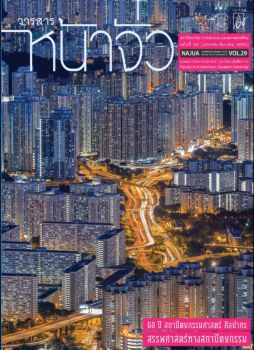แผนที่มรดกทางวัฒนธรรม อำเภอแม่แจ่ม จังหวัดเชียงใหม่
Keywords:
แผนที่มรดกทางวัฒนธรรม, เมืองแม่แจ่ม, Cultural Heritage Maps, Mae Chaem TownAbstract
บทความวิชาการนี้ เป็นผลจากการศึกษาวิจัยเรื่อง “โครงการศึกษาและจัดทำแผนที่มรดกทางวัฒนธรรม เพื่อ พัฒนาที่อยู่อาศัยชุมชนดั้งเดิมและมรดกทางวัฒนธรรม อำเภอแม่แจ่ม จังหวัดเชียงใหม่” สนับสนุนงบประมาณโดยการ เคหะแห่งชาติ ที่เห็นความสำคัญของอำเภอแม่แจ่มว่ายังคงมีเรือนไม้ที่มีคุณค่าทางสถาปัตยกรรมพื้นถิ่นจำนวนมาก รวม ถึงอาคารทางศาสนา สิ่งศักดิ์สิทธิ์ประจำเมืองและหมู่บ้าน ตลาด ฯลฯ ความงามของสภาพแวดล้อมแบบเมืองในหุบเขา วิถีชีวิต วัฒนธรรมประเพณี จึงมีความเหมาะสมที่จะเป็นแหล่งท่องเที่ยวหรือเรียนรู้ด้านมรดกทางวัฒนธรรม การศึกษามี วัตถุประสงค์เพื่อ 1) ศึกษา สำรวจ และระบุอาคารในชุมชนที่อยู่อาศัยดั้งเดิม แหล่งหรือบริเวณมรดก โดยระบุที่ตั้ง พิกัด รูปแบบสถาปัตยกรรม คุณค่าทางประวัติศาสตร์ สังคมและเศรษฐกิจ ผ่านกระบวนการมีส่วนร่วมของคนในพื้นที่ 2) จัดระบบ และบันทึกแหล่งมรดกทางวัฒนธรรมทั้งที่จับต้องได้และจับต้องไม่ได้ 3) ประเมินความเสี่ยงขั้นต้นของมรดกทางวัฒนธรรม และเสนอแนวทางเบื้องต้นในการอนุรักษ์มรดกทางวัฒนธรรม ผลการศึกษา ได้จัดระบบมรดกทางวัฒนธรรมของเมือง แม่แจ่มออกเป็น 7 ประเภท ได้แก่ แหล่งประวัติศาสตร์ วัด ร้านค้าและเคหสถาน สถานที่ศักดิ์สิทธิ์ แหล่งภูมิปัญญาท้อง ถิ่น แหล่งพิธีกรรม และแหล่งอื่นๆ รวมจำนวน 86 แห่ง การจัดทำแผนที่มรดกทางวัฒนธรรมได้นำเสนอแผนที่ในภาพ รวมทั้งเมือง และแผนที่ขยายในอีก 4 บริเวณ แสดงสัญลักษณ์ของแหล่งมรดกแต่ละประเภทเพื่อการสืบค้นเชื่อมโยงไปยัง เนื้อหาที่ประกอบด้วย พิกัดที่ตั้ง ประวัติความเป็นมา สิ่งสำคัญและจุดเด่น เจ้าของหรือผู้ครอบครอง และภาพถ่าย การ ประเมินความเสี่ยงในเบื้องต้นกับมรดกทางวัฒนธรรมที่จับต้องได้ (แหล่งประวัติศาสตร์ วัด ร้านค้าและเคหสถาน สถาน ที่ศักดิ์สิทธิ์) ใช้เกณฑ์พิจารณา 3 ข้อ ได้แก่ 1) การเสื่อมโทรมทางกายภาพ 2) การเปลี่ยนแปลงจากสภาพดั้งเดิม และ 3) การเปลี่ยนแปลงสภาพแวดล้อม โดยประเมินระดับความเสี่ยงเป็น สูง กลาง และตํ่า มรดกทางวัฒนธรรมที่จับต้องไม่ได้ (ภูมิปัญญาท้องถิ่น พิธีกรรม และอื่นๆ) ใช้การพิจารณาความเสี่ยงจากปัจจัยที่เกี่ยวข้อง ส่วนข้อเสนอแนะด้านการอนุรักษ์ มีทั้งมาตรการบังคับและจูงใจ โดยใช้กระบวนการมีส่วนร่วมในการจัดทำและตัวแผนที่มรดกทางวัฒนธรรมเป็นเครื่องมือ ให้คนแม่แจ่มและหน่วยงานที่เกี่ยวข้อง ใช้ประกอบการวางแผนอนุรักษ์และพัฒนาชุมชนดั้งเดิมที่มีมรดกทางวัฒนธรรม ทรงคุณค่าให้คงอยู่ต่อไปได้
Cultural Heritage Maps of Mae Chaem District, Chiang Mai Province
Suebpong Chansuebsri
Lecturer, The Faculty of Art and Architecture, Rajamangala University of Technology Lanna
Isara Guntang
Lecturer, The Faculty of Art and Architecture, Rajamangala University of Technology Lanna
Surapol Manowong
Associate Professor, The Faculty of Art and Architecture, Rajamangala University of Technology Lanna
This article is the results of the project “studying and making of cultural heritage maps for traditional habitat community and cultural heritage development in Mae Chaem district, Chiang Mai province”. This research were supported by National Housing Authority who saw the importance of Mae Chaem district where lots of the traditional wooden houses with valuable local architecture still existed as well as religious buildings, local sacred places, markets, etc. The beautiful environment of this valley city along with lifestyle, culture and tradition made it the proper place for tourism and cultural heritage study. The objectives of the research were 1.) To study, explore and identify old buildings in traditional habitat communities and heritage places or areas by pinpointing location, coordination, and architectural pattern as well as historical, social and economic values using local people participation process. 2.) To organize and make a record of tangible and intangible cultural heritages. 3.) To evaluate primary risks and present basic solutions to conserve these cultural heritages. In result, cultural heritages in Mae Chaem city were classified into 7 categories including historical site, temple, store and homestead, sacred place, local wisdom site, ritual site, and other site with a total of 86 places. The making of cultural heritage maps presented overall city map and four scaled up area maps with indications on each heritage category for linking to its contents including coordination and location, history, importance and distinction, owner or possessor, and photo. The evaluation of primary risks for tangible cultural heritages (historical site, temple, store and homestead, sacred place) used three criterions to consider including 1) physical deterioration 2) originated transformation and 3) environmental transformation with evaluation levels of high, medium, and low. For intangible cultural heritages (local wisdom, ritual, etc.), the evaluation considered associated factors. For conserving suggestion, both compulsory and persuasive measures must be complied by local people participation process. Also by using cultural heritage maps as a tool, Mae Chaem’s citizens and associated corporations could make traditional community conserving and developing plans to protect their valuable cultural heritages to remain existed as they should be.





